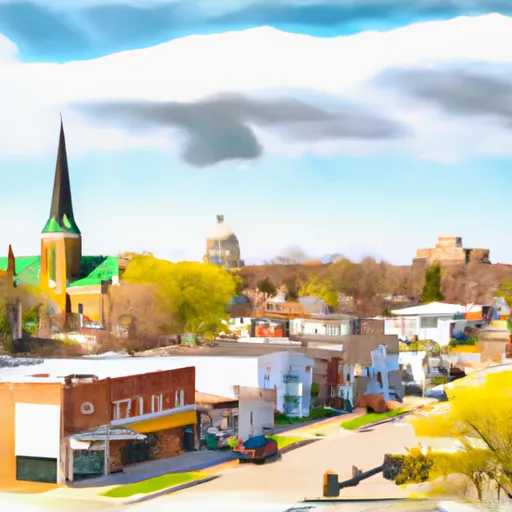-
 Snoflo Premium
Snoflo Premium
Get unlimited access to all our content
With no Ad interruptions! - Start Your Free Trial Login with existing account
Lagrange
Eden Index
Climate
7.5
•
Recreation
4.0
•
Community
1.5
•
Safeguard
4.7/10

Lagrange, Indiana, is a charming town located in LaGrange County in the northeastern part of the state. The climate in Lagrange is considered continental, with warm summers and cold winters. Average temperatures range from the mid-80s°F in summer to the mid-20s°F in winter, providing a diverse range of outdoor experiences throughout the year.
Hydrologically, Lagrange is blessed with numerous lakes, rivers, and ponds. The county is home to over 100 natural lakes, making it a haven for water enthusiasts. These water bodies offer opportunities for boating, fishing, swimming, and other water sports. Popular lakes in the area include Lake James, Sylvan Lake, and Oliver Lake.
Apart from water-related activities, Lagrange County boasts several picturesque parks and nature reserves. The LaGrange County Park offers hiking trails, picnic areas, and opportunities for wildlife observation. Pine Knob Park features rolling hills, woodlands, and a disc golf course. Shipshewana Flea Market and Auction is another notable attraction where visitors can explore unique finds from over 900 vendors.
In summary, Lagrange, Indiana, provides a pleasant climate, abundant hydrological features, and a range of outdoor recreational opportunities, making it an ideal destination for nature lovers and outdoor enthusiasts.
What is the Eden Index?
The Snoflo Eden Index serves as a comprehensive rating system for regions, evaluating their desirability through a holistic assessment of climate health, outdoor recreation opportunities, and natural disaster risk, acknowledging the profound impact of these factors on livability and well-being.
Climate Health Indicator (CHI): 7.5
Lagrange receives approximately
950mm of rain per year,
with humidity levels near 84%
and air temperatures averaging around
10°C.
Lagrange has a plant hardyness factor of
5, meaning
plants and agriculture in this region thrive during a short period during spring and early summer. Most
plants will die off during the colder winter months.
By considering the ideal temperature range, reliable water supplies, clean air, and stable seasonal rain or snowpacks, the Climate Health Indicator (CHI) underscores the significance of a healthy climate as the foundation for quality living.
A healthy climate is paramount for ensuring a high quality of life and livability in a region, fostering both physical well-being and environmental harmony. This can be characterized by ideal temperatures, reliable access to water supplies, clean air, and consistent seasonal rain or snowpacks.
Weather Forecast
Streamflow Conditions
Southeastern Lake Michigan
Area Rivers
Southeastern Lake Michigan
Snowpack Depths
Southeastern Lake Michigan
Reservoir Storage Capacity
Southeastern Lake Michigan
Groundwater Levels
Recreational Opportunity Index (ROI): 4.0
The Recreational Opportunity Index (ROI) recognizes the value of outdoor recreational options, such as parks, hiking trails, camping sites, and fishing spots, while acknowledging that climate plays a pivotal role in ensuring the comfort and consistency of these experiences.
Access to outdoor recreational opportunities, encompassing activities such as parks, hiking, camping, and fishing, is crucial for overall well-being, and the climate plays a pivotal role in enabling and enhancing these experiences, ensuring that individuals can engage in nature-based activities comfortably and consistently.
Camping Areas
| Campground | Campsites | Reservations | Toilets | Showers | Elevation |
|---|---|---|---|---|---|
| Hidden Diamonds City Park | None | 901 ft | |||
| Kil-So-Quah - J. Edward Roush Lake | 90 | 807 ft | |||
| Versailles State Park | 225 | 965 ft | |||
| Nottawa Park | 20 | 831 ft | |||
| Lake Clare Park Camp | 18 | 746 ft | |||
| Pigeon River State Fish and Wildlife Area | 45 | 911 ft | |||
| Cade Lake County Park | 62 | 869 ft | |||
| Chain OLakes State Park | 410 | 956 ft | |||
| Cold Brook County Park | 51 | 941 ft | |||
| Bixler Lake City Campground | 100 | 965 ft |
Nearby Ski Areas
Catastrophe Safeguard Index (CSI):
The Catastrophe Safeguard Index (CSI) recognizes that natural disaster risk, encompassing floods, fires, hurricanes, and tornadoes, can drastically affect safety and the overall appeal of an area.
The level of natural disaster risk in a region significantly affects safety and the overall livability, with climate change amplifying these risks by potentially increasing the frequency and intensity of events like floods, fires, hurricanes, and tornadoes, thereby posing substantial challenges to community resilience and well-being.
Community Resilience Indicator (CRI): 1.5
The Community Resilience Indicator (CRI) recognizes that education, healthcare, and socioeconomics are crucial to the well-being of a region. The CRI acknowledges the profound impact of these elements on residents' overall quality of life. By evaluating educational resources, healthcare accessibility, and economic inclusivity, the index captures the essential aspects that contribute to a thriving community, fostering resident satisfaction, equity, and social cohesion.

